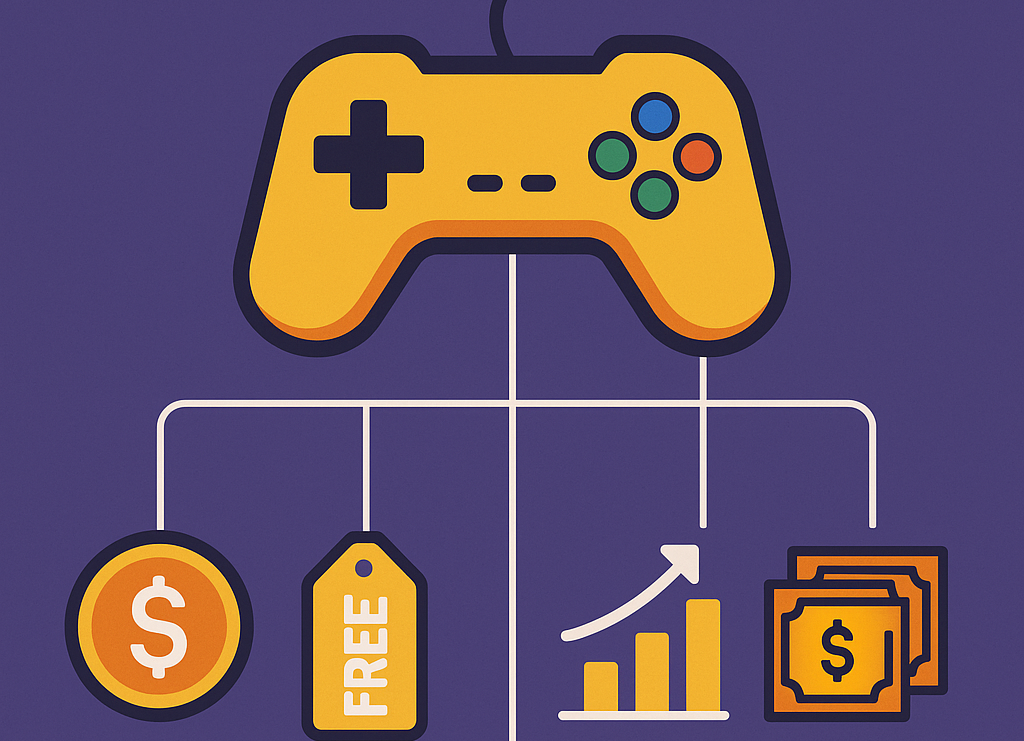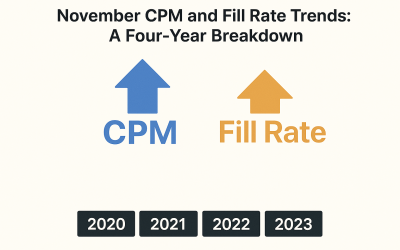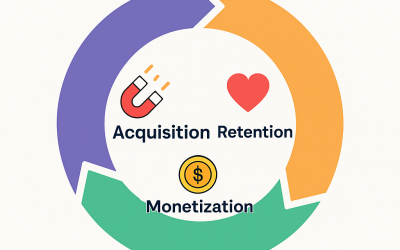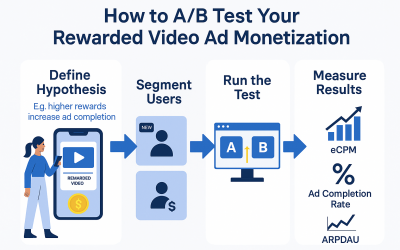The Ultimate Guide to Game Monetization Models and Metrics
Game monetization has evolved into a sophisticated science, especially for mobile and web-based games. In an increasingly global and competitive market – forecasted to exceed $98 billion in mobile game revenue by the end of 2024– developers must understand key monetization models and performance metrics to maximize revenue. This guide provides a comprehensive deep-dive into the essential metrics of modern game monetization: CPM, CPC, CPI, eCPM, ARPDAU, and more. For each metric, we’ll explain what it is, when to use it, and how to optimize it. The focus is on actionable insights for game developers (with the latest post-2023 trends), helping you choose the right models and improve your game’s financial performance without compromising player experience.
Before diving into the metrics, remember that game monetization models generally fall into a few categories:
- In-App Advertising (IAA) – earning money by showing ads to players.
- In-App Purchases (IAP) – selling virtual goods or upgrades within the game
- Premium or Paid Games – upfront purchase price for the game.
- Subscriptions – recurring payments for exclusive content or perks.
- Hybrid Models – combining two or more methods (very common in today’s games).
Each model uses different Key Performance Indicators (KPIs) to gauge success. Advertising-based models rely on metrics like CPM, CPC, and eCPM, while IAP models focus on ARPU, ARPPU, and conversion rates – and all games benefit from tracking blended metrics like ARPDAU and LTV. Understanding these metrics in a global context (user acquisition costs, ad rates, and player spending can vary widely by region) is crucial for modern game developers. Now, let’s break down each metric and how you can leverage it.
Contents
CPM (Cost Per Mille)
What it is: CPM is an advertising term meaning “cost per mille,” i.e. cost per 1,000 ad impressions. It represents how much an advertiser pays to have their ad shown a thousand times. For example, a $5 CPM means the advertiser pays $5 for every 1,000 views of their ad. CPM is a pricing model widely used in online and mobile advertising. From a developer’s perspective, if you’re showing ads in your game, the CPM determines your revenue per thousand ad impressions served to players.
How to optimize CPM:
As a developer, you cannot directly set CPM (advertisers and networks do), but you can take steps to increase the effective CPM you earn:
-
Attract High-Value Users:
Advertising demand (and CPM) is higher for users who are more likely to spend or engage. Targeting or acquiring users from regions with higher ad spend (e.g. North America, Western Europe) can lift CPM. Also, games with older or higher-income audiences may see better ad rates.
-
Improve Ad Placement & Viewability:
Place ads where users will actually see them (high viewability). Ads shown “above the fold” or at natural breaks (level completion, etc.) tend to command higher CPM. Ensure your game’s ad placements aren’t easily ignored or skipped. For example, rewarded videos that the player opts into usually have very high CPMs because of their completion rate and user attention.
-
Keep Users Engaged: Poor user engagement can hurt CPMs
. Advertisers pay more when players are deeply engaged (and thus likely to pay attention to ads). Focus on good game design and retention – longer session lengths and higher DAU/MAU ratios mean players see more ads and are more valuable to advertisers. One tip is to offer optional rewarded ads for in-game rewards at points of need, which has been shown to increase both player retention and ARPU while improving ad revenue. With such strategies, you not only show more ads per user but also maintain a positive experience, which can indirectly lift CPM (advertisers love high-retention games).
By combining these tactics, you can raise the CPMs your game commands, meaning more revenue from the ads you show. Keep an eye on industry benchmarks and seasonal trends too. Ad rates often peak during Q4 holiday season and dip in January – recognizing these patterns helps set realistic expectations for CPM.
CPC (Cost Per Click)
What it is: CPC stands for “Cost Per Click,” also known as pay-per-click. It’s an advertising pricing model where advertisers pay only when a user clicks on their ad. For example, if a campaign has a $0.50 CPC, the advertiser pays $0.50 each time someone actually clicks the ad (regardless of how many times the ad was shown without clicks). CPC is a metric that primarily matters to advertisers (it tells them how much each click costs), but it can also impact developers in certain monetization setups (e.g. if you use an ad network that pays per click rather than per impression). CPC is commonly associated with search ads and banner ads, and major platforms like Google Ads and Facebook Ads heavily use the CPC model.
How to optimize CPC:
Whether you’re paying for clicks or earning from clicks, the goal is to make each click count. Here are some tips to optimize CPC in practice:
-
For User Acquisition (advertiser perspective):
To lower the cost per click you pay on campaigns, focus on ad relevance and quality. Ad platforms like Google use Quality Score algorithms – if your ad is very relevant and gets a high click-through rate, the platform rewards you with lower CPC bids. Ensure your ad creative is compelling (eye-catching visuals, clear call-to-action) and tightly target your audience so that those who see the ad are likely to click. High relevance not only improves performance but can literally reduce the price you pay per click. It’s also important to A/B test ad copies and creatives to improve CTR; even small improvements in CTR can reduce CPC over time due to the way ad auctions favor engaging ads. Moreover, optimize your keywords and targeting: for example, on search ads, bid on keywords that are specific and intent-driven (rather than broad terms where competition – and thus CPC – is high). Broadening your audience can sometimes lower CPC (less competition), but ensure those clicks are still coming from users who might install or spend in your game. In summary, higher ad quality + better targeting = lower CPC.
-
For Monetization (publisher perspective):
If you earn revenue per ad click, the priority is to increase click-through rate (CTR) without harming user experience. Place ads in spots that catch the eye but aren’t purely accidental click-bait (misleading placements can annoy users and advertisers). Native ads or rewarded offer walls (where users intentionally click to earn something) can yield good CPC revenue. To optimize, make sure ads shown are relevant to your audience (many ad networks do auto-optimization here). You can also try formats like interactive ads or playable ads – these often engage users more, leading to clicks. However, always monitor if higher clicks might hurt retention (e.g., if an ad click takes users out of your game too often, they might not return). Balance is key.
In general, CPC is about quality over quantity. A low CPC is good when you’re acquiring users (it means cheaper traffic), but if that traffic doesn’t convert to installs or paying users, even $0.10 per click is wasted money. Conversely, from an earnings standpoint, a high CPC ad might scare some developers away from using it (fearing users leaving the game upon click), but if integrated smartly (say, an offer wall where users choose to click for a reward), it can add a nice revenue stream. Always measure the downstream effects of clicks – whether it’s install conversion rate or user retention after clicking ads – to truly optimize your strategy around CPC.
CPI (Cost Per Install)
What it is: CPI stands for “Cost Per Install.” This metric denotes how much you pay, on average, to acquire a new user who installs your game via advertising. It’s calculated simply as total ad spend divided by the number of new installs generated by that spend. For example, if you spent $1,000 on an ad campaign and it brought in 500 installs, your CPI is $2.00. Unlike CPC (which counts clicks), CPI goes a step further down the funnel – you only count an install once a user has actually downloaded and opened the game. Many mobile marketing campaigns, especially “app install” campaigns on networks like Unity Ads, IronSource, Facebook, AppLixir etc., operate on a CPI model (you might set a target CPI bid, or pay per install directly).
How to optimize CPI:
Lowering your CPI means you acquire users more cost-effectively. Here are strategies to optimize CPI for your campaigns:
-
Improve Ad Targeting and Channel Selection:
Broadly, the more precisely you can target high-potential users, the better your conversion rates and the lower your effective CPI. Focus on ad channels that reach your game’s audience efficiently. For example, if your game is a casual puzzle game, advertising on channels popular with casual mobile users (like social media or hyper-casual cross-promotions) might yield better CPIs than, say, a hardcore gamer ad network. Optimize by region as well: if CPIs in certain countries are too high, allocate more budget to countries where you see a favorable balance of CPI vs. LTV. Many developers spread their budget across various networks (Facebook/Meta, Google UAC, TikTok, Unity Ads, etc.) and then double down on the ones with the best CPI-to-LTV performance. Monitoring CPI by campaign and region is essential – you might find, for example, that CPI on iOS in Tier-1 countries is expensive post-2021 (due to privacy changes), so you invest more in Android or in lookalike audiences that yield cheaper installs.
-
Optimize Creatives:
Ad creative has a huge impact on CPI. A compelling video or playable ad that showcases your gameplay and highlights what hooks players will convert viewers to installers at a higher rate, effectively lowering the cost per install. Continuously A/B test different creatives (videos, images, playables) and track which ones drive the most installs per dollar. Sometimes even small changes (different tagline, or showing a popular feature) can improve conversion. Higher click-through and conversion on ads raises the number of installs you get for the same spend – driving CPI down.
-
Use Retargeting and Lookalike Audiences:
- Many ad platforms let you target users similar to your best customers (lookalikes) or re-target lapsed players. These strategies can yield better install rates. A lookalike audience based on your paying users, for example, might install at a higher rate (and potentially be more valuable post-install), making your effective CPI for quality users better.Ultimately, optimizing CPI is about efficiency: spend your marketing dollars where they bring in the most users who will actually play and pay. Keep a close eye on CPI vs. LTV – as one expert rule suggests, never pay more to acquire a user than they’re worth. If your CPI is higher than your per-user revenue, you either need to lower that CPI or improve your monetization (or both). Many successful studios iterate on both sides of this equation: lowering CPI through better marketing and raising LTV (see LTV section) through better monetization design.
eCPM (Effective Cost Per Mille)
What it is: eCPM stands for “effective Cost Per Mille”, sometimes also called effective CPM. It’s a derived metric that calculates the revenue earned per 1,000 ad impressions, regardless of the pricing model of those ads. In formula terms:
For example, if you earned $100 from 50,000 ad impressions, your eCPM is ($100/50,000)*1,000 = $2.00. The beauty of eCPM is that it normalizes revenue across different ad campaigns or networks. Whether an ad was CPI, CPC, or CPM, you can express the outcome as eCPM to compare performance. From a developer’s viewpoint, eCPM tells you how well a particular ad placement or ad network is monetizing your game’s impressions. If one ad network yields an eCPM of $10 and another $5, the former is effectively earning you twice as much per impression, even if their payment models differ.
How to optimize eCPM:
Many of the tactics to improve CPM (discussed earlier) apply to eCPM as well, since CPM is essentially the baseline pricing. But here, think specifically in terms of maximizing revenue per impression on your side. Key strategies include:
-
Maximize Competition (Use Mediation):
If you haven’t yet, integrate an ad mediation platform that lets multiple ad networks bid on each impression (real-time bidding or waterfall). The more bidders, the higher the winning bids on average, which raises your eCPM. Also consider adding direct deals or cross-promotion campaigns if you have them, but ensure they meet a decent eCPM. Some developers set a “floor” eCPM in mediation – for example, don’t fill an impression unless it will pay at least $X eCPM. This can improve average eCPM (but watch out for fill rate drops if set too high).
-
Improve User Engagement & Retention:
It may sound like a user metric, but it strongly affects eCPM. If your users are highly engaged (playing many sessions, sticking around for weeks), advertisers will often see better performance and thus the ad networks’ algorithms will send higher-paying ads. Engaged users also simply generate more impressions each (giving the ad network more chances to show a high-value ad). Avoid spamming too many ads early on, as that can drive users away (churn hurts your long-term ad revenue). Instead, integrate ads thoughtfully so that users accept them as part of the game or even opt-in. For instance, using rewarded ads strategically can actually boost retention and LTV, creating a positive cycle: better retention → more impressions per user → higher total revenue and often higher eCPM (since those users might move into “high value” buckets for advertisers).
-
Geo and Platform Optimization:
Monitor your eCPM by country and platform. You may discover, for example, that your eCPM on iOS is higher than Android (common in some regions), or that certain countries have very low eCPM. With this info, you might adjust your user acquisition focus to channels that bring users from higher eCPM regions. Or if you have a large audience in a low-eCPM region, consider if you can add other monetization methods (like IAP or a subscription) for those users to supplement ad revenue. Essentially, lean into audiences that give good eCPM, and don’t overspend on UA for regions where eCPM (and likely LTV) is very low unless you have volume to make up for it.
In short, eCPM is your scoreboard for ad monetization efficiency. Regularly review it. If you see a dip in eCPM, investigate: Is it a seasonal trend? Did a big advertiser pull out? Or did a recent game update hurt engagement? Conversely, track when eCPM rises and try to replicate those conditions (e.g., higher eCPM during an in-game event might indicate advertisers bid more when your DAU surges). As an example of a recent trend, Unity’s 2024 report showed in-app ad ARPDAU (closely related to eCPM times ad frequency) jumped ~26.7% year-over-year from 2022 to 2023, as more studios optimized ads to counterbalance lower player spending. That means many developers managed to earn more ad revenue per user – likely through a combination of these eCPM-boosting strategies and showing more ads to engaged players. You can do the same by continuously fine-tuning your ad setup for maximum yield.
ARPDAU (Average Revenue Per Daily Active User)
What it is: ARPDAU stands for “Average Revenue Per Daily Active User.” It measures how much revenue you earn, on average, per DAU (daily active user). In formula, for a given day:
How to optimize ARPDAU:
Increasing ARPDAU means earning more from each active user per day, on average. You can do this either by increasing revenue (more purchases, more ads watched) per user or by focusing on retaining only more valuable users (which is not usually desired – generally you want to keep all users, but if a change causes low-value users to drop out, ARPDAU might actually rise since the average of the remainder is higher). Ideally, you raise ARPDAU by offering more opportunities for willing players to spend or engage with monetization, without pushing away the non-spenders. Here are some techniques:
-
Incorporate Rewarded Ads Smartly:
As mentioned earlier, rewarded ads can increase revenue and keep players happy when done right. Placing them at natural points (e.g., “watch an ad to continue” or “watch for a free reward”) can significantly raise the average revenue per user. Some players will watch many ads if they’re getting something useful, while those who don’t want to can skip – meaning you monetize the willing without enraging the rest. This can lift ARPDAU (because a portion of users now contribute ad revenue) and possibly even increase retention or time spent, which in turn creates more ad opportunities. A win-win: developers have reported that offering optional video ads for rewards boosted retention and ARPU simultaneously. In practice, more sessions and higher engagement from these tactics give more chances to earn per user per day.
-
Upsell Non-payers (Conversion):
A key to raising ARPDAU in IAP-supported games is converting some non-spending users into payers. Even a small purchase from a fraction of your DAU will raise the average revenue per user. Introduce low-price, high-value offers especially aimed at first-time spenders (the classic “starter pack” for $0.99 that’s very juicy). Also, highlight the value of items – make sure players understand what they gain. If currently 2% of your daily users pay, moving that to 3% will lift ARPDAU noticeably. Use techniques like first purchase rewards (give a bonus for the first IAP), limited time offers, or gentle reminders of sales. This relates to the conversion rate metric (percentage of DAU who are paying users), which if improved will bump ARPDAU.
-
Monitor and Balance Ads vs. IAP:
One challenge in optimizing ARPDAU is the balance between ad-based and purchase-based revenue. If you lean too much on ads, some players who might have spent money could just consume ads for free rewards (diminishing IAP revenue). Conversely, if you limit rewards and push only IAP, you leave ad money on the table from non-payers. The current trend is hybrid monetization – find the mix. Some developers offer an “ad removal” IAP to get the best of both worlds: if a user really dislikes ads, they pay to remove them (you get IAP revenue), otherwise they’ll watch ads (you get ad revenue). Hybrid strategies have become more important recently to maximize ARPDAU across a broad player base. For instance, in 2023 many studios saw that if players weren’t spending due to economic reasons, adding more ad opportunities kept revenue flowing. You should regularly analyze what fraction of ARPDAU comes from ads vs. IAP, and adjust your game design or offers if one could be higher without harming the other.
In practice, think of ARPDAU as the daily report card of how well you are monetizing. If your DAU stays constant but you implement a change (new feature, new ad network, etc.), ARPDAU will reflect the impact almost immediately. Track it alongside retention: sometimes ARPDAU can go up while retention goes down – that’s a red flag you might be too aggressive (a short-term ARPDAU gain at the cost of long-term player loss). The best scenario is increasing ARPDAU while keeping retention steady or even improving it (meaning you’re making more per user and keeping them happy). Optimize through small experiments and keep an eye on ARPDAU as your guiding metric for monetization success.



